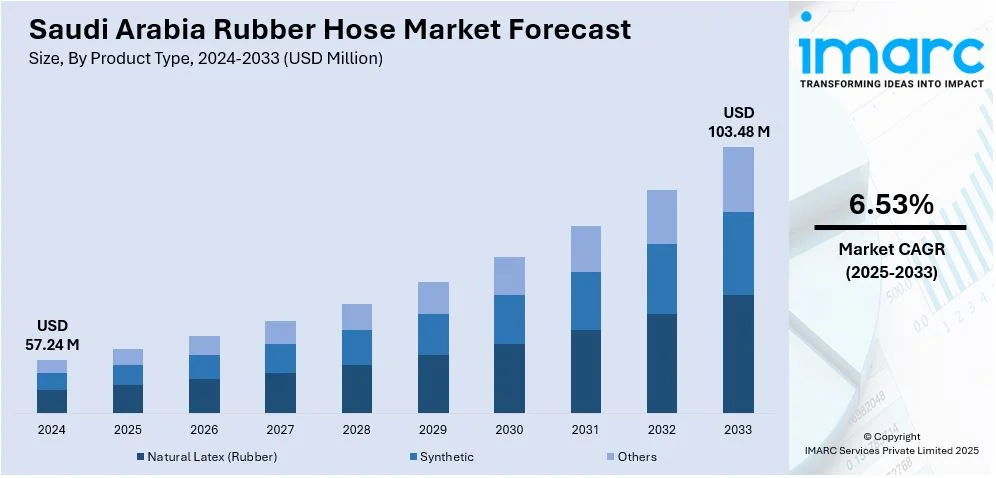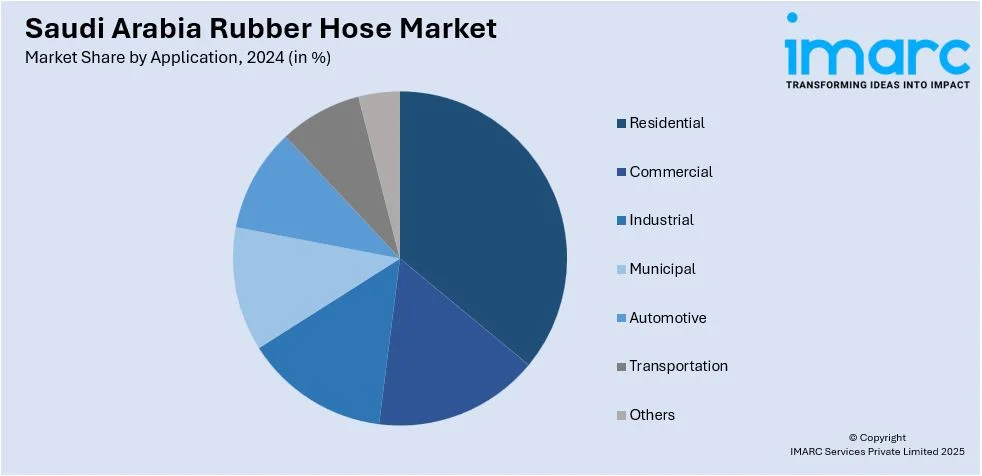
Saudi Arabia Rubber Hose Market Size, Share, Trends and Forecast by Product Type, Media, Pressure Rating, Application, and Region, 2025-2033
Saudi Arabia Rubber Hose Market Overview:
The Saudi Arabia rubber hose market size reached USD 57.24 Million in 2024. Looking forward, IMARC Group expects the market to reach USD 103.48 Million by 2033, exhibiting a growth rate (CAGR) of 6.53% during 2025-2033. The market is growing because of increasing industrial usage, particularly within the construction, automotive, and oil industries. Growing demand for flexible, abrasion-resistant material fuels product advancements. Developments in materials technology are influencing market movement, along with the enlargement of domestic capabilities to produce goods.
|
Report Attribute
|
Key Statistics
|
|---|---|
|
Base Year
|
2024
|
|
Forecast Years
|
2025-2033
|
|
Historical Years
|
2019-2024
|
| Market Size in 2024 | USD 57.24 Million |
| Market Forecast in 2033 | USD 103.48 Million |
| Market Growth Rate 2025-2033 | 6.53% |
Saudi Arabia Rubber Hose Market Trends:
Technological Advancements and Innovations in Material Science
The Saudi Arabian rubber hose market is in the midst of a boom of technological innovation, led most predominantly by technological advances in material science. More resilient hose production, temperature-resistant at both high and low levels, and has greater tensile strength is taking center stage as an area of focus for producers. As more industries like oil and gas, automotive, and construction grow, there is increased demand for hoses that can handle tough conditions. Advances in rubber compound technology are making it possible to develop hoses with greater abrasion, corrosion, and pressure resistance. Synthetic rubber products, for instance, and specialty coatings are being utilized more frequently as they provide higher performance in aggressive environments. In addition, the ability to customize hose products to match specific industrial needs is becoming a Saudi Arabian supplier differentiator. In response to these trends, local manufacturers are adopting novel manufacturing techniques that allow for more efficient and cost-effective production of rubber hoses. These technologies improve not only the performance of rubber hoses but also their durability, which makes them more desirable to industries relying on long-term reliability, further supporting the rubber hose market growth.

Expanding Industrial Demand for Rubber Hoses
Saudi Arabian industrialization is emerging as one of the key drivers of the Saudi rubber hose market. Sectors such as construction, oil and gas, and automotive are fueling demand for industrial-grade rubber hoses used for transferring fluid and gas. With heavy investments in building infrastructure and increased focus on industrial diversification, the market is expanding at a rapid rate. In recent years, mega projects such as Neom smart city and oil and gas exploration projects have generated an enormous demand for rubber hoses. These are essential in transporting various fluids, such as oil, gas, and water, in commercial and industrial applications. In addition, the automotive industry is seeing expansion due to increased demand for rubber hoses used in engine cooling, brakes, and fuel systems. This growing industrial demand has encouraged the establishment of domestic manufacturing plants, reducing reliance on imports and increasing competitiveness. Saudi Arabia's Vision 2030, with diversification away from oil reliance, propels the need for infrastructure and industrial goods even further. The rubber hose market forecast reflects this growing momentum, highlighting the sector's critical role in supporting the country's long-term industrial and economic goals.
Saudi Arabia Rubber Hose Market Segmentation:
IMARC Group provides an analysis of the key trends in each segment of the market, along with forecasts at the country and regional level for 2025-2033. Our report has categorized the market based on product type, media, pressure rating, application.
Product Type Insights:
- Natural Latex (Rubber)
- Synthetic
- Others
The report has provided a detailed breakup and analysis of the market based on the product type. This includes natural latex (rubber), synthetic, and others.
Media Insights:
- Water
- Oil
- Hot Water and Steam
- Air/Gas
- Food and Beverage
- Chemical
A detailed breakup and analysis of the market based on the media have also been provided in the report. This includes water, oil, hot water and steam, air/gas, food and beverage, and chemical.
Pressure Rating Insights:
- Low
- Medium
- High
A detailed breakup and analysis of the market based on the pressure rating have also been provided in the report. This includes low, medium, and high.
Application Insights:

- Residential
- Commercial
- Industrial
- Municipal
- Automotive
- Transportation
- Others
A detailed breakup and analysis of the market based on the application have also been provided in the report. This includes residential, commercial, industrial, municipal, automotive, transportation, and others.
Regional Insights:
- Northern and Central Region
- Western Region
- Eastern Region
- Southern Region
The report has also provided a comprehensive analysis of all the major regional markets, which include Northern and Central Region, Western Region, Eastern Region, and Southern Region.
Competitive Landscape:
The market research report has also provided a comprehensive analysis of the competitive landscape. Competitive analysis such as market structure, key player positioning, top winning strategies, competitive dashboard, and company evaluation quadrant has been covered in the report. Also, detailed profiles of all major companies have been provided.
Saudi Arabia Rubber Hose Market News:
- July 2024: Amiantit Rubber Industries Ltd. (ARIL) continued expanding its rubber product range, including specialized rubber hoses for industrial applications. This move bolstered the Saudi Arabian rubber hose market by enhancing product variety and reliability, supporting the growing demand in sectors like construction and defense.
- June 2024: Mcneil Saudi Arabia expanded its presence in the rubber hose market by delivering high-quality Hydraulic Jack Hose Pipes. These hoses, designed for high-pressure applications, enhanced the reliability and efficiency of hydraulic systems, supporting sectors like automotive and construction, and strengthening the local market.
Saudi Arabia Rubber Hose Market Report Coverage:
| Report Features | Details |
|---|---|
| Base Year of the Analysis | 2024 |
| Historical Period | 2019-2024 |
| Forecast Period | 2025-2033 |
| Units | Million USD |
| Scope of the Report |
Exploration of Historical Trends and Market Outlook, Industry Catalysts and Challenges, Segment-Wise Historical and Future Market Assessment:
|
| Product Types Covered | Natural Latex (Rubber), Synthetic, Others |
| Medias Covered | Water, Oil, Hot Water and Steam, Air/Gas, Food and Beverage, Chemical |
| Pressure Ratings Covered | Low, Medium, High |
| Applications Covered | Residential, Commercial, Industrial, Municipal, Automotive, Transportation, Others |
| Regions Covered | Northern and Central Region, Western Region, Eastern Region, Southern Region |
| Customization Scope | 10% Free Customization |
| Post-Sale Analyst Support | 10-12 Weeks |
| Delivery Format | PDF and Excel through Email (We can also provide the editable version of the report in PPT/Word format on special request) |
Key Questions Answered in This Report:
- How has the Saudi Arabia rubber hose market performed so far and how will it perform in the coming years?
- What is the breakup of the Saudi Arabia rubber hose market on the basis of the product type?
- What is the breakup of the Saudi Arabia rubber hose market on the basis of the media?
- What is the breakup of the Saudi Arabia rubber hose market on the basis of pressure rating?
- What is the breakup of the Saudi Arabia rubber hose market on the basis of application?
- What is the breakup of the Saudi Arabia rubber hose market on the basis of region?
- What are the various stages in the value chain of the Saudi Arabia rubber hose market?
- What are the key driving factors and challenges in the Saudi Arabia rubber hose?
- What is the structure of the Saudi Arabia rubber hose market and who are the key players?
- What is the degree of competition in the Saudi Arabia rubber hose market?
Key Benefits for Stakeholders:
- IMARC’s industry report offers a comprehensive quantitative analysis of various market segments, historical and current market trends, market forecasts, and dynamics of the Saudi Arabia rubber hose market from 2019-2033.
- The research report provides the latest information on the market drivers, challenges, and opportunities in the Saudi Arabia rubber hose market.
- Porter's five forces analysis assist stakeholders in assessing the impact of new entrants, competitive rivalry, supplier power, buyer power, and the threat of substitution. It helps stakeholders to analyze the level of competition within the Saudi Arabia rubber hose industry and its attractiveness.
- Competitive landscape allows stakeholders to understand their competitive environment and provides an insight into the current positions of key players in the market.
Need more help?
- Speak to our experienced analysts for insights on the current market scenarios.
- Include additional segments and countries to customize the report as per your requirement.
- Gain an unparalleled competitive advantage in your domain by understanding how to utilize the report and positively impacting your operations and revenue.
- For further assistance, please connect with our analysts.
 Request Customization
Request Customization
 Speak to an Analyst
Speak to an Analyst
 Request Brochure
Request Brochure
 Inquire Before Buying
Inquire Before Buying




.webp)




.webp)












